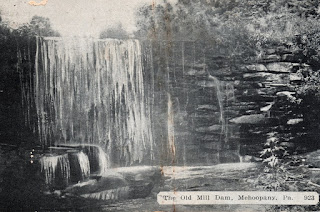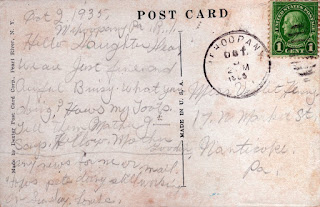Mrs. Burges, Kati Decker, Helen Comstrek, Mrs. Decker, Mrs. Brooks,
Sara Kinton, Mrs. Kerthline, Mate Bordon. Ruth Decker, Fanny Bordon,Mary Jay. Lil Jayne. Photographer: Fred Jennings, Mehoopany, Pa.
This is a little off-topic...actually, not as much as the stories about the mill, so I guess I'll proceed. The photo above is a scan of a postcard I found from Laceyville, Pennsylvania's beautiful website (the link to the original story is below). The Jennings family's history as of yet holds no historical connection with Laceyville. In any case, the page on the site relates the important use of these postcards or "cabinet cards" in genealogy.
Two things caught my eye: the photographer's name and the location of his studio! It turns out that "Fred. Jennings" was my Great-Grand Uncle, making him the son of Grandfather Charles; he owned a store on the same side of the Little Mehoopany Creek, as was the Jennings Hotel (owned by William).
The BIG problem is the caption, which -- I gather -- contains a boat-load of misspellings, as well a lot of familial connections IF the misspellings are truly that. For example, Burges is probably Burgess, Comstrek is probably Comstock, and -- the most intriguing of them all -- Sara Kinton should be Sarah Kintner. Sarah's connection with the family is very interesting: as of the 1860 census, she was listed as living with the Jennings family (occupation "beermaid"), and not yet married to Frank Jennings, who was photographer Fred's uncle.
I'm going to end here, because I'm waiting for conformation of the names from the owner of the card. If I'm right, this will not be the last time I'll be blogging about this photo.




